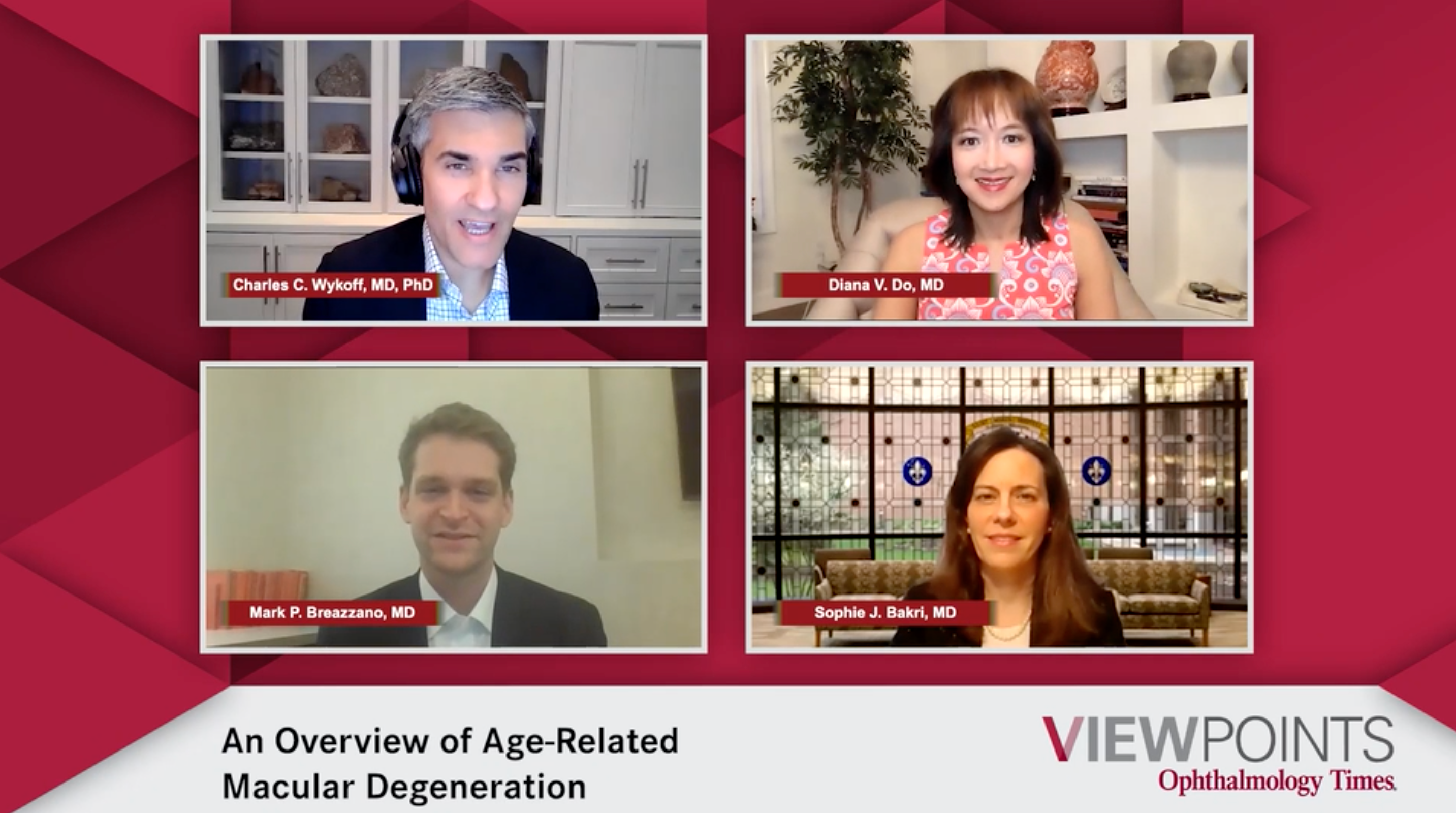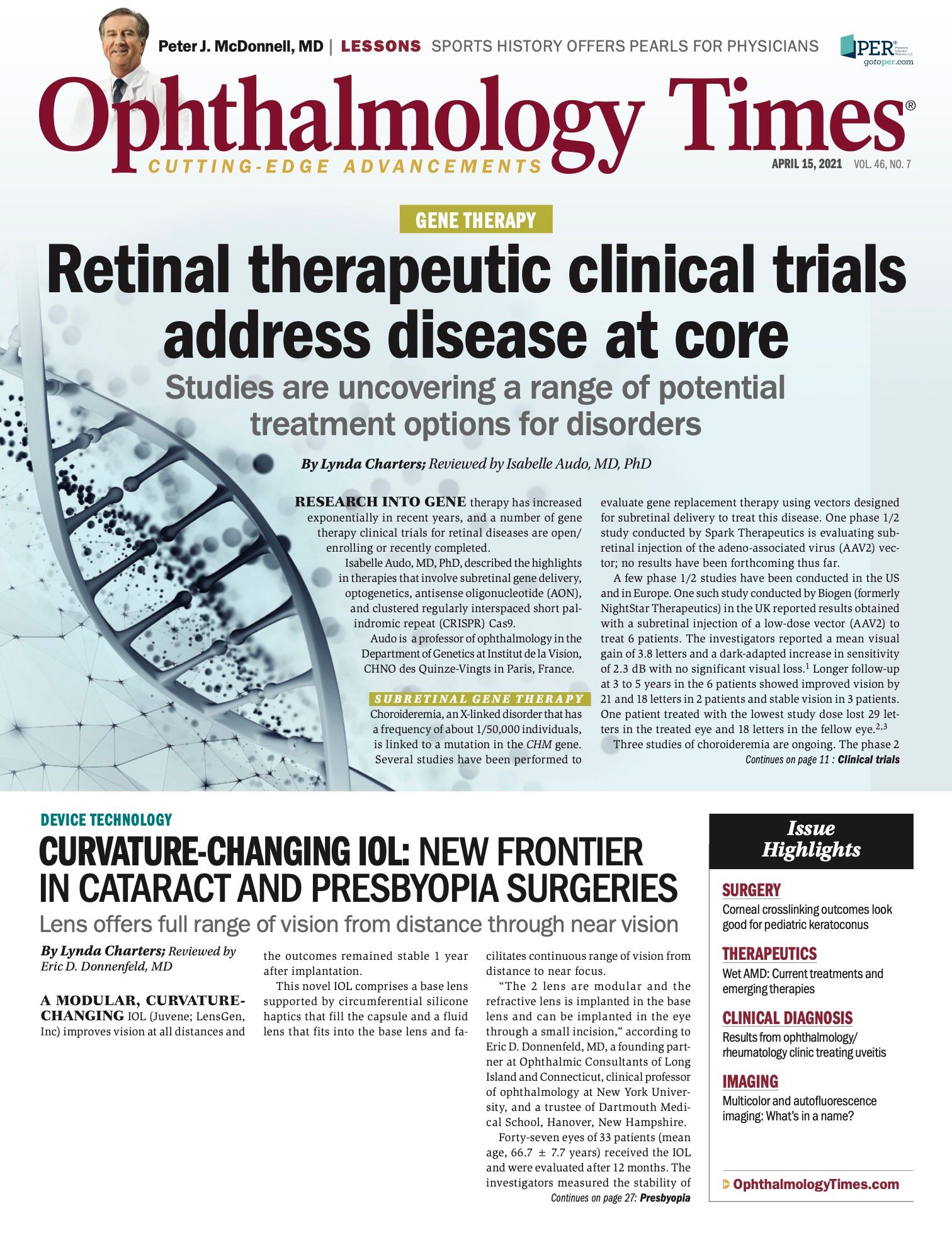News
Article
Digital Edition
Wet AMD: Current therapies and treatment
Author(s):
Experts discuss durability of action and atrophy inhibitor among primary treatment goals.
Key opinion leaders in ophthalmology provide an overview of age-related macular degeneration and comment on clinical recommendations for assessing symptoms.

Reviewed by Charles Wykoff, MD; Mark Breazzano, MD; and Diana Do, MD
Retina experts gathered virtually for the Ophthalmology Times® Viewpoint series to discuss the current treatment landscape and latest potential treatment strategies for wet age-related macular degeneration (AMD).
The panel included moderator Charles Wykoff, MD, PhD, Retina Consultants of Texas, Houston; and panelists Diana Do, MD, professor of ophthalmology and vice chair for clinical affairs at the Byers Eye Institute, Stanford University School of Medicine, Palo Alto, California; Mark Breazzano, MD, assistant professor of ophthalmology, Wilmer Eye Institute, Johns Hopkins University, Baltimore, Maryland; and Sophie Bakri, MD, chair and professor of ophthalmology, Mayo Clinic, Rochester, Minnesota.
The panelists opened with a discussion of their typical patients; that is, over age 55 years and mostly symptomatic depending on the stage and bilaterality of their AMD.
For these patients, Breazzano advises use of Age-Related Eye Disease Study 2 (AREDS2) vitamins for patients with intermediate or late AMD because of the potential reduced chances of second-eye conversion or development of late complications.
The COVID-19 pandemic was identified as having a major effect on in-person examinations, resulting in delayed treatment and possible visual loss.
Although telemedicine grew in importance in other specialties, it is less valuable for wet AMD and more useful for stable retinal diseases, Do explained.
Treatment
The most frequently used anti-VEGF drugs are off-label bevacizumab (Avastin; Genentech Inc.), and the FDA-approved products ranibizumab (Lucentis; Genentech Inc.) and aflibercept (Eylea; Regeneron Pharmaceuticals).
“Bevacizumab has a high binding affinity for VEGF and strong results for treating wet AMD. Ranibizumab, a monoclonal fragment approved specifically for wet AMD, is similar in efficacy and profile for treating AMD to bevacizumab,” Breazzano said. “Aflibercept may provide better visual results in certain cases. The drug binds VEGF-A, -B and placental growth factor.”
Do noted that evidence gathered over 15 years shows the efficacy and safety of these medicines.
“I wholeheartedly suggest immediate treatment if patients have wet AMD,” Do said.
Bakri said she also recommends injections and points out the absence of a good alternative to injections, with emphasis on visual preservation, possible visual improvement, and patient adherence.
Safety
Explaining treatment risks, especially endophthalmitis, is important to Breazzano.
“Although the risk is low, this can be decreased by antisepsis of the eye,” he explained. He advises instilling artificial tears to quell irritation after treatment. He also encourages patients to not ignore any worrisome signs.
All physicians were concerned with the intraocular inflammation caused by brolucizumab (Beovu; Novartis).
“During postmarketing surveillance of this drug, episodes of intraocular inflammation with retinal artery occlusion were reported,” Do said. “This is a new adverse effect that the other anti-VEGF agents do not have.”
New AMD type
Wykoff mentioned a nonexudative neovascular form of AMD, a lesion that grows between Bruch’s membranes and the retinal pigment epithelium. These are often characterized by a double-layer sign on structural OCT.
Moreover, OCT angiography (OCTA) can visualize these lesions but there is no associated subretinal or intraretinal fluid, and typically patients are asymptomatic.
About 10% to 20% of the patients with geographic atrophy (GA) and intermediate dry AMD may harbor these lesions, which are important to identify clinically because there appears to be greater risk of development of wet AMD requiring treatment compared to eyes without these lesions.
Imaging
Do and Bakri both pointed out that OCTA can be hard to interpret and both rely on fluorescein angiography to diagnosis active wet AMD.
Bakri related that in some cases it is impossible to know whether a lesion is leaking.
“In select cases when leakage is seen on fluorescein but the lesion is not well visualized on OCT, I use OCTA because I can noninvasively monitor patients,” she said.
Treatment burden
Bakri and Breazzano said they prefer to treat and extend. Both treat, wait 4 weeks, reinject, and then reevaluate patients based on treatment response, extending the treatment interval to 6 weeks, for example, if sufficient.
However, the extent of the treat-and-extend regimen depends on the patient, with some able to go 16 weeks between injections, although these are the minority.
Do said she uses loading doses to aggressively treat choroidal neovascularization (CNV) before treating and extending because of the marked VA improvement and reduced retinal thickening during that first 3 to 6 months of treatment initiation.
Emerging therapies
For Do, faricimab (Roche), a bispecific molecule that inhibits VEGF and angiopoietin-2, is an in-office treatment.
The phase 3 clinical trials results showed that faricimab was effective, safe, and noninferior to aflibercept. Faricimab can be dosed every 16 weeks in about 45% of subjects, suggesting extended CNV inhibition.
KSI-301, an intravitreal anti-VEGF agent on an antibody biopolymer conjugate platform (Kodiak Sciences), exhibited extended durability in trials.
The phase 1b data from 121 treatment-naïve patients with wet AMD, diabetic macular edema, or retinal vein occlusion indicated that two-thirds of patients had a 6-month treatment-free interval after receiving 3 loading doses and 1-year follow-up.
Bakri said she believes the surgically implanted Port Delivery System (Genentech) with ranibizumab is promising, with results comparable to monthly ranibizumab. A phase 2 trial showed many patients had refills after longer than 9 months, and some after 15 months.
The device is under FDA evaluation.
Gene therapy treatments RGx-314 (REGENXBIO) and ADVM-022 (Adverum Biotechnologies) may positively affect retina practices. The 1-year data from the RGX-314 phase 2/d and 3 clinical trials showed that most patients were injection free.
ADVM-022 involves 1 intravitreal injection. The 1-year results showed that 1 cohort needed no rescue injections, he noted.
Wykoff mentioned OPT-302 (Opthea), which inhibits VEGF-C, VEGF-D, and VEGF-A with concurrent ranibizumab or aflibercept administration. A phase 2 trial reported superior visual outcomes compared to ranibizumab monotherapy. A global phase 3 program will start enrollment shortly.
Do mentioned the tyrosine kinase inhibitors (TKI) axitinib (Clearside Biomedical), a suprachoroidal injection with possible beneficial effects and long action; sunitinib (Graybug Vision), an every-6-month intravitreal injection; and vorolanib (EyePoint Pharmaceuticals), a sustained-delivery TKI.
Wykoff said release of phase 3 data from a study of pegcetacoplan (Apellis), a C3 cleavage inhibitor, is expected in the second half of 2021.
This molecule is being studied for its potential to slow GA progression and if approved, would be the first therapy for GA.
Unmet retinal needs
These include treatment efficiency and decreased treatment burden, atrophy and fibrosis addressed with regenerative therapies, identification of upstream/downstream factors that cause atrophy, and drugs with increased duration of action.
--
Charles Wykoff, MD, PhD
e:ccwmd@retinaconsultantstexas.com
Wycoff has no financial disclosures related to this content.
Diana Do, MD
e:dianado@stanford.edu
Do has no financial disclosures related to this content.
Mark Breazzano, MD
e:mbreazz1@jhmi.edu
Breazzano has no financial disclosures related to this content.
Sophie Bakri, MD
e:Bakri.Sophie@mayo.edu
Bakri has no financial disclosures related to this content.

Newsletter
Don’t miss out—get Ophthalmology Times updates on the latest clinical advancements and expert interviews, straight to your inbox.





